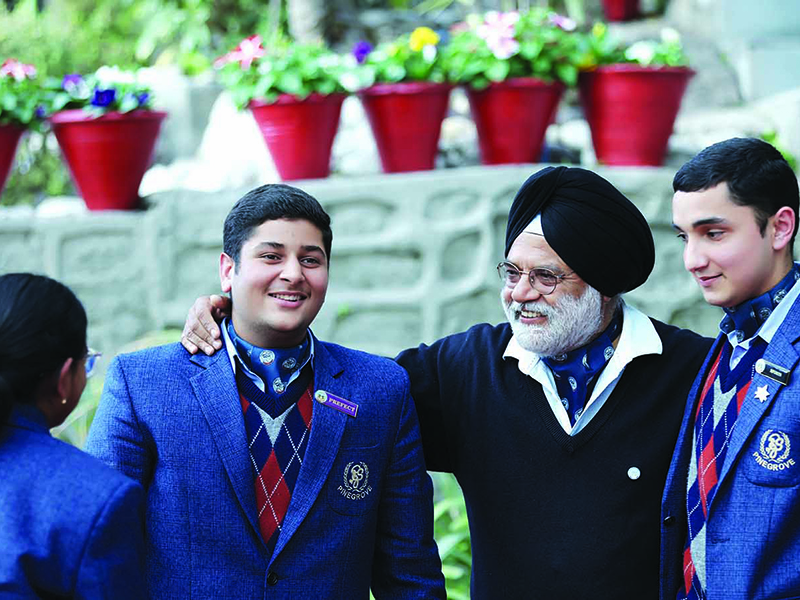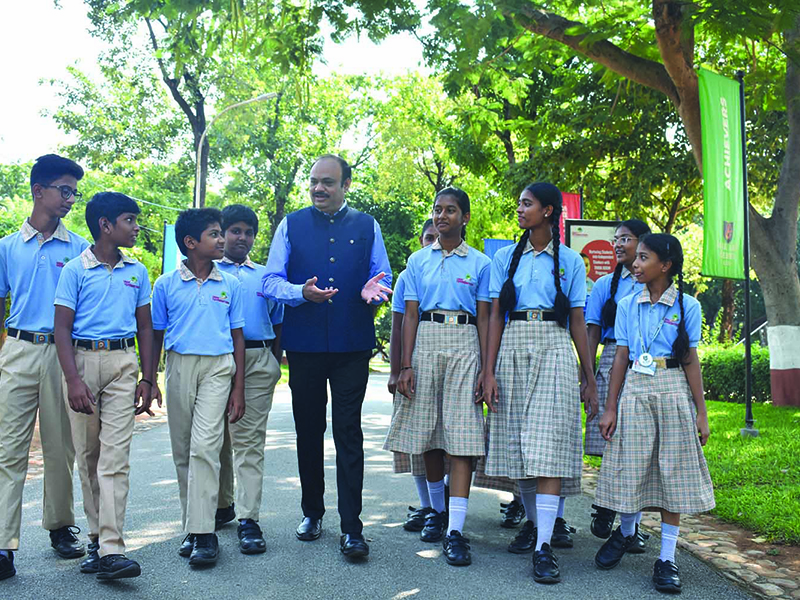India’s top-ranked co-ed boarding schools 2024-25
Offering pure, unpolluted air and excellent academic, co-curricular, sports and games facilities, while considerably reducing the stress and strain of latter-day parenting, co-ed boarding schools are experiencing a surge of popularity within upper middle and elite classes.
For a nation taking its own time to march into modernity, co-ed schools in which male and girl children learn together and begin to practice gender egalitarianism and mutual respect in early age, are the way to go. These nation-building practices are best learned in co-ed boarding schools hosting children far removed from their home environments and providing neutral spaces to learn the virtues of independence and developing life skills of coexisting in peace and harmony with children from diverse cultures and backgrounds.
In the new globalised world shrunk by trade, jet travel and the internet, lessons and life experiences that boarding schools — especially co-ed — provide children are invaluable. Particularly since the worst excesses of boarding schools such as cold showers, the lash, ‘gatings’ and prolonged isolation from family— commonplace in yesteryear boarding schools — are history.
On the contrary, usually sited in pristine hills far from the country’s increasingly unlivable cities choked with road traffic and air pollution, they offer pure air and excellent academic, co-curricular, sports and games facilities, providing ideal environments for the healthy growth and development of children. Simultaneously, progressive boarding schools considerably reduce the stress and strains of latter day parenting. For all these reasons co-ed residential schools are experiencing a resurgence of popularity within the upper middle and elite classes of Indian society.
In the annual EducationWorld India School Rankings, since 2022, boarding — indeed all schools — have been divided into two categories: newly established latter-day and ‘vintage legacy’ (over 90 years of age) to provide a level playing field and eliminate apples and oranges type evaluation. The parameters under which they are rated are common, except for ‘quality of alumni’ applicable only to vintage schools which have graduated large batches of students who have moved up corporate and other ladders. On the other hand, graduates of newly-promoted schools haven’t had sufficient time to make their mark.
Against this backdrop of co-ed boarding schools becoming increasingly popular with the upper middle and elite households, it’s unsurprising that Capt. A.J. Singh, the cheerful Promoter-Director of Pinegrove School, Dharampur (PGD, estb.1991), is “highly elated” that this 30-year-old class VI-XII CBSE-affiliated school sited on two scenic campuses spread over 50 acres in the Himalayan foothills, is ranked India #1 for the second year in succession with highest scores under six of 14 parameters of school education excellence prescribed by EducationWorld.
“All of us in PGD are elated that our school is re-ranked #1 countrywide in this competitive category by a new set of sample respondents. I believe our USP (unique sales proposition) is the sincerity with which all our stakeholders — teachers, parents and staff — work towards improving the happiness quotient of our children,” says Singh, an alum of the National Defence Academy, Khadakvasla, Indian Military Academy, Dehradun and College of Materials Management, Jabalpur who took to teaching after serving for 10 years in the Indian Army.
Singh is especially satisfied that PGD is awarded top scores under the parameters of teacher welfare and development, faculty competence, and mental and emotional well-being services and second highest score under pastoral care.
“All these parameters are linked. We recruit the best teachers from across the country and because we accord highest importance to their welfare and continuous training and development, we retain them. As a result our teachers have not only developed high academic expertise, but also the life skills to ensure the mental and emotional well-being of our children through provision of high quality pastoral care. With easy access to a wide range of co-curricular and sports education facilities, our boys and girls have the advantage of truly holistic education in a nurturing and caring environment,” says Singh who modestly attributes PGD’s highest score under the leadership/management parameter to the school’s team.
Also accommodated at top table are the consistently high ranked Chinmaya International, Coimbatore and SelaQui International, Dehradun jointly ranked #2, followed by the Assam Valley School, Balipara (Assam) at #3 (ranked #2 in 2023-24), Kasiga School, Dehradun also #3 (4), the low-profile Miles Bronson School, Guwahati at #4 (4) and Punjab Public School, Nabha #5 (6) debuting at top table together with the New Era High School, Panchgani (10) which has been awarded a big promotion.
Aarash Javanmardi, an engineering graduate of Mumbai University and former operations manager at IBM, India (2006-12) who was called in to help New Era, Panchagani (NEP, estb.1945) digitise its operations, but stayed on to teach at his alma mater and was appointed principal in 2021, is delighted with the “wonderful news” of a big promotion from #10 in 2023-24 to #5 and #1 in Maharashtra this year. “This promotion is a rejuvenating shot in the arm for NEP and will prompt us to double our institution development efforts with new vigour,” says Javanmardi (“a Persian origin surname”).
Javanmardi is pleased that this year’s 8,700 sample respondents have not only awarded NEP (which provided the location for the hit multiple intelligences movie Taare Zamin Par starring Aamir Khan) a big promotion in the overall ranking, but also a good score under the double weightage faculty competence parameter. “This is the outcome of the intensive training and professional development programmes of four-five days — in addition to CBSE prescribed training — that our teachers experience four times per year, before every holiday break. These programmes also deliver all-important pastoral care training which explains our good score under this parameter. I am also glad about our good scores under the safety and hygiene and infrastructure parameters because we have installed 200 CCTV cameras on our 24-acre campus, and have recently constructed a new academic block,” says Javanmardi. Currently, this CBSE-affiliated K-12 co-ed boarding school has 918 children mentored by 65 teachers on its muster rolls.
Beyond top table, there’s been substantial rearrangement of the seating order in the Top 10 table of India’s most admired co-ed boarding schools. The superbly equipped Anubhuti School, Jalgaon is promoted to #6 (7), co-ranked with Taurian World School, Ranchi which has vaulted to #6 (from #13 in 2023-24). While two Krishnamurti Foundation schools — Sahyadri, Pune and Rajghat Besant, Varanasi — have been obliged to cede ground, the newly-promoted, fully furbished Sai International School, Cuttack #8 (10) and Sagar School, Alwar (Rajasthan) #9 (10) have been awarded well-deserved promotions.
Incidentally, Sai International and Sagar School are the top-ranked co-ed boarding schools in the states of Odisha (pop. 46 million) and Rajasthan (81 million) respectively. Isha Home School, Coimbatore promoted by well-known lifestyle guru Sadhguru Jaggi Vasudev, which has been steadily losing ground due to communication deficit, completes the Top 10 league table.
Arguably because the Bangalore-based AZ Research Partners constituted a broad-based sample respondents database comprising SEC (socio-economic category) ‘A’ and ‘B’ households as opposed to exclusively SEC ‘A’ hitherto, the greatest churn in rankings has occurred beyond the Top 10 league table. A large number of previously modestly ranked co-ed boarding schools sited in Tier-II and Tier-III cities and towns have recorded spectacular gains in the nether reaches of the 69-strong national league table.
For instance, the recently (2015) promoted Ivy International School, Shimla has made a great leap forward in the esteem of the informed public to #11 from #20 in 2023-24. Ditto St. Michael’s, Siliguri to #12 (25), Velammal Residential School, Sivganga #18 (35), Aryan School, Dehradun #19 (34), Himali Boarding School, Kurseong #20 (28) and Father LeBlond School, Siliguri #20 (40).
The big promotion from #22 in 2023-24 to #14 nationally and #1 in Andhra Pradesh is “cloud nine news” for Rajesh Patil, Principal of the Sri Vidyanikethan International School, Tirupati (SVIS, estb.1993), a fully-furbished co-ed boarding school promoted three decades ago by Dr. Mohan Babu, a well-known Telugu cinema star in memory of his father, a school teacher in the temple town of Tirupati. Unobtrusively, the CBSE-affiliated SVIS which hosts 620 students mentored by 56 teachers, has acquired an excellent reputation attracting ten admission applications for every vacancy in primary school.
“Over the past 30 years the SVIS management has laid an excellent foundation on which this school has been built. As a result we attract students from all over the country and some from abroad. Credit for this should accrue to the management and our dedicated and committed teachers, some of whom have been with us for over 25 years,” says Patil, an alum of Amravati University who acquired valuable admin and teaching experience in DPS, Indore (2006-16) and DPS, Aurangabad (2016-21) prior to his appointment as principal of SVIS in 2021.
Patil is especially satisfied with the high scores awarded to the school under the parameters of teacher competence, academic reputation, co-curricular and sports education. “High scores under these parameters is proof that our well-trained and very competent teachers are providing excellent academic and supplementary education to our children in a safe and secure environment. That’s why I am also pleased about our good score under mental and emotional well-being services. In SVIS providing a balanced, happy learning experience — we have 13 clubs comprising herbal garden, heritage studies and a wide range of sports options including horse-riding — to our students in the spiritual environment of Tirupati is our prime objective,” says Patil.
Beyond the Top 20, other co-ed boarding schools that have been awarded big promotions this year are St. Paul’s Senior Secondary, Abu Road (Rajasthan) ranked #24 (47), Slopeland Public School, Khongjom (Manipur) #34 (39), the previously unranked Mukeshbhai R. Patel Boys and Girls Military School, Dhule (Maharashtra) #35 and the Kaziranga English Academy #37 (52).
It is pertinent to bear in mind that co-ed boarding schools which have to build hostels and extensive facilities for co-curricular and sports are necessarily capital-intensive institutions. Therefore all the 69 co-ed boarding schools listed in the national league table are national assets, most of whom even if modestly ranked nationally are likely to be much prized institutions of consequence in their host states.
All the 69 co-ed boarding schools listed are national assets. Even if modestly ranked nationally they are likely to be much prized institutions in their host states




















Add comment